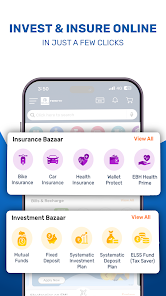In the modern digital era, managing car insurance has become more convenient thanks to insurance apps. These applications provide vehicle owners with the ability to access policy information, file claims, and compare coverage options—all from the convenience of a smartphone. Much like how a fixed deposit provides a secure and structured investment path, an insurance app offers a structured and organized approach to selecting and managing car insurance policies. Understanding the coverage options available through these apps is essential for making informed decisions and ensuring comprehensive protection for your vehicle.

Why Car Insurance Apps Are Gaining Popularity
The rise of smartphones and digital solutions has transformed the insurance landscape. Car insurance apps are gaining popularity because they reduce the need for physical paperwork and lengthy procedures. Vehicle owners can now explore policy details, premium amounts, and coverage options at their own pace. These apps act as a one-stop solution for managing all aspects of car insurance, making them a valuable tool for anyone looking to streamline their insurance experience.
An insurance app is particularly helpful for those who want quick access to coverage details or need to compare multiple policies. Users can easily check their policy status, renew insurance, or even receive alerts for upcoming payments. Much like a fixed deposit that grows securely over time, an insurance app ensures your policy management remains organized and efficient, eliminating unnecessary delays.
Key Coverage Options in Car Insurance Apps
Understanding the various types of coverage offered through car insurance apps is crucial. These options help policyholders determine the level of protection they need based on their vehicle type, driving habits, and financial situation. Most apps provide a detailed explanation of coverage options, ensuring users can make informed choices.
Liability Coverage
Liability coverage is one of the most fundamental components of car insurance. It covers damages or injuries caused to other people or their property in an accident where the policyholder is at fault. Through an insurance app, users can quickly view the limits of liability coverage and adjust them based on their risk tolerance. Having clear liability coverage ensures that unexpected expenses from accidents do not become a financial burden.
Comprehensive Coverage
Comprehensive coverage protects against damages to your vehicle from non-collision events such as theft, natural disasters, fire, or vandalism. Car insurance apps often provide detailed options to customize comprehensive coverage based on the vehicle’s value and usage. Just as a fixed deposit safeguards your investment, comprehensive coverage ensures that your vehicle is protected against unforeseen events.
Collision Coverage
Collision coverage pays for damages to your car resulting from an accident, regardless of who is at fault. Through an insurance app, users can select coverage limits that align with their vehicle’s market value. Collision coverage is particularly beneficial for newer cars or vehicles with high repair costs, offering peace of mind to the policyholder.
Personal Injury Protection
Some car insurance apps also include options for personal injury protection. This type of coverage assists with medical expenses for you and your passengers in case of an accident. The app interface allows users to check claim procedures and eligible amounts, making the process faster and more transparent.
Add-Ons and Customizations
Car insurance apps provide flexibility by offering various add-ons, such as roadside assistance, zero depreciation coverage, and engine protection. Users can customize their policies based on their needs, ensuring they receive comprehensive protection without paying for unnecessary services. The ability to manage add-ons digitally saves time and provides clarity on policy benefits.
How to Evaluate Coverage Through an Insurance App
Evaluating coverage through an insurance app requires careful consideration of your needs and budget. Start by comparing different coverage options and understanding the extent of protection they offer. Many apps feature comparison tools, allowing users to assess multiple policies side by side. By reviewing premium amounts, coverage limits, and deductibles, policyholders can make decisions that balance protection with affordability.
Another important aspect is checking claim support and user reviews. An insurance app that offers seamless claim filing and reliable support adds significant value. Just as a fixed deposit ensures steady returns over time, selecting an app with transparent services and user-friendly interfaces ensures a hassle-free insurance experience.
Benefits of Using Car Insurance Apps
Using car insurance apps provides multiple advantages beyond policy management:
- Convenience: Policy details and coverage options are available anytime, anywhere.
- Efficiency: Quick claim filing and payment tracking reduce time spent on paperwork.
- Transparency: Clear breakdowns of premiums, coverage, and deductibles improve decision-making.
- Cost-Effectiveness: Comparing multiple policies helps users select coverage that fits their budget without compromising on protection.
- Reminders and Alerts: Users receive notifications for renewals, claim updates, and policy changes, reducing the risk of lapses.
The organized approach offered by insurance apps resembles the structured nature of a fixed deposit—helping users keep their investments or insurance policies on track without stress.
Tips for Choosing the Right Coverage in an Insurance App
- Assess Your Needs: Consider the age and condition of your vehicle, driving habits, and risk tolerance.
- Compare Policies: Use the app’s comparison features to evaluate coverage limits, premiums, and deductibles.
- Understand Add-Ons: Determine which optional coverages are necessary for your situation.
- Check Customer Support: Ensure the app provides prompt assistance in case of claims or queries.
- Review Reviews: Reading user experiences can highlight the app’s efficiency and reliability.
Selecting coverage through an insurance app allows users to make informed choices, ensuring comprehensive protection while staying within budget.
Conclusion
Car insurance apps have simplified the way individuals manage vehicle insurance, offering clarity, convenience, and efficiency. By understanding the coverage options available—liability, comprehensive, collision, and personal injury protection—users can make informed decisions tailored to their needs. Just as a fixed deposit provides a secure and structured approach to growing your savings, an insurance app provides a structured and convenient platform to manage and optimize your car insurance coverage.
By exploring policy options and customizing coverage through these apps, vehicle owners can ensure complete protection without unnecessary stress. In the age of digital solutions, adopting an insurance app is no longer a luxury but a practical tool for securing both your vehicle and your financial peace of mind.

